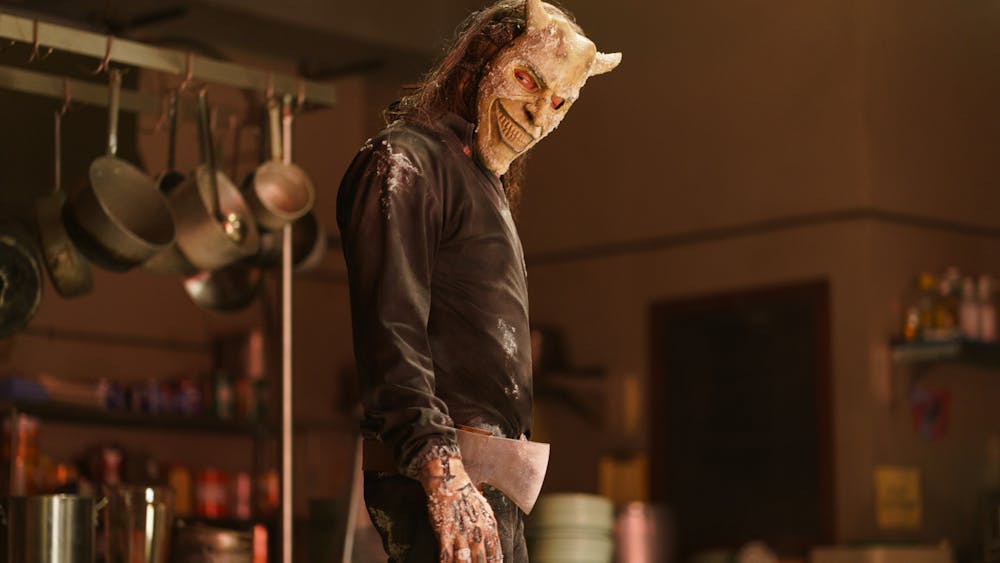Meteorology students partner with alumni owned winery

Photo courtesy of Marty Baxter | Meteorology students set up a tripod at Bonobo Winery in Traverse City to track weather changes in the Old Mission Peninsula on Nov. 18, 2015.
Meteorology faculty members and students spent a day at Bonobo Winery in Traverse City in November setting up equipment to survey weather patterns in Old Mission Peninsula.
Now, the station is providing data to help CMU alumnus and Bonobo owner Todd Oosterhouse schedule when to plant his grapes to ensure the best wine.
"We put it in during the late summer and we'll get some good data from it in the winter and into the spring during the next couple of months here," Oosterhouse said. "For us personally, we're able to use this data more so in the future."
The idea to work with the winery and tracking weather patterns was presented by Chesaning alumnus Kevin Price, who took part in the Summer Scholars Program. The program awards undergraduates a summer stipend of up to $3,500 through the Office of Research and Graduate studies to help students with costs associated with a research or creative project done in cooperation with a CMU faculty member over the summer.
"There aren't many weather stations in the peninsula and we want closer observations to verify the forecast," Price said. "This happens by setting up equipment, tracking the weather patterns and verifying the data that comes through."
The biggest issue with wine making is predicting the frost and freezing points in the seasons. Cold weather can significantly damage the vines. The weather station gives winemakers can get a better idea of how to grow the vines and what times of the year are best for harvesting.
"Freeze events are not easy to track without the proper equipment," Price said. "If we can track these events on a smaller, finer scale it will help keep an eye out for the plants. By looking at these shifts in the weather and using a finer resolution to look at them, we can make it easier for farmers and better for the wine."
Associate Professor of Meteorology Marty Baxter was one of the professors who accompanied students on the trip to the winery. He and his students set up a equipment which measured temperature, wind, moisture, pressure and rainfall in the area.
"(After measuring) the data is automatically downloaded to Weather Underground so we can look at it wherever we are and track what is happening," Baxter said. "We hope to put more of these stations up and get students more involved in the research."
Grand Ledge freshman and meteorology student Adam Batz says he went on the one day expedition to the winery on a whim, after receiving an email from a professor about an optional field trip.
"As a freshman, it was a really great to be able to get to know students and faculty within my major and learn about the opportunities I can get involved in," Batz said.
Batz helped set up equipment and made sure everything was correctly assembled to accurately gather the data. He hopes to go to graduate school and work in the private sector of meteorology.
The most ideal climates for wine-making are states like California with warm climates. In Michigan, the winters become too cold and can harm the vines and impact quality of the grapes. Hail is also something known to the Michigan climate and can physically damage the vines.
The Bonobo Winery owns 50 acres, 19 of them fully planted with grapes. They make classical dry white wines such as chardonnay and pinot grigio. Due to the cool climate they can only make a select type of red wines.
After the fruit is fermented and processed, the fruit juice is fermented until there is no more sugar left; this is dry wine. McCarthy says that reds are aged to four years and up to ten months for whites, both in oak barrels. The wine then gets filtered out and left to age in the bottle for a couple months before sale.
Oosterhouse said while winemaking may seem "glamorous in many aspects," much of what he does depends on the weather when he farms.
"Whether it be a storm, hot day, cold day, those factors affect what kind of crop we're going to get. So having this weather station at our winery will help us plan for the future," he said. "When you know things like humidity and dew point at every second of the day it helps you better predict when to spray or pick the plants."
Oosterhouse said he's glad to be involved with the university and help out in terms of giving students opportunities to use real data. The data from the weather station can be used by professors in their classes and also helps the winemakers.
"(Winemaking is) a living, breathing thing," Oosterhouse said. "You could do all the tests in the world but sometimes you need to feel what's happening with the skin and get the texture of the wine."



